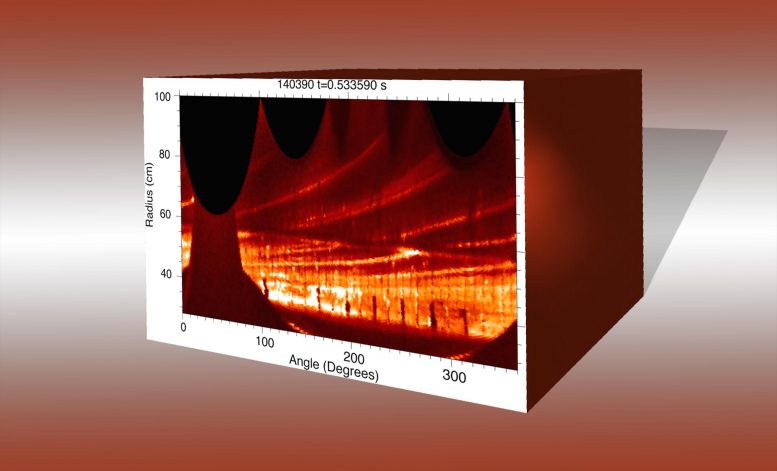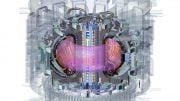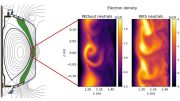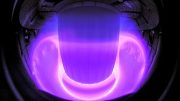
Image showing spiraling magnetic field fluctuations at the edge of the NSTX tokamak. Credit: Physics of Plasmas. Composition by Elle Starkman/Office of Communications
Blobs can wreak havoc in plasma required for fusion reactions. This bubble-like turbulence swells up at the edge of fusion plasmas and drains heat from the edge, limiting the efficiency of fusion reactions in doughnut-shaped fusion facilities called “tokamaks.” Researchers at the U.S. Department of Energy’s (DOE) Princeton Plasma Physics Laboratory (PPPL) have now discovered a surprising correlation of the blobs with fluctuations of the magnetic field that confines the plasma fueling fusion reactions in the device core.
New aspect of understanding
Further investigation of this correlation and its role in the loss of heat from magnetic fusion reactors will help to produce on Earth the fusion energy that powers the sun and stars. “These results add a new aspect to our understanding of the plasma edge heat loss in a tokamak,” said physicist Stewart Zweben, lead author of a paper in Physics of Plasmas that editors have selected as a featured article. “This work also contributes to our understanding of the physics of blobs, which can help to predict the performance of tokamak fusion reactors.”
Fusion reactions combine light elements in the form of plasma — the hot, charged state of matter composed of free electrons and atomic nuclei that makes up 99 percent of the visible universe — to produce massive amounts of energy. Scientists are seeking to create and control fusion on Earth as a source of safe, clean, and virtually limitless power to generate electricity.
PPPL researchers discovered the surprising link last year when re-analyzing experiments made in 2010 on PPPL’s National Spherical Torus Experiment (NSTX) — the forerunner of today’s National Spherical Torus Experiment-Upgrade (NSTX-U). The blobs and fluctuations in the magnetic field, called “magnetohydrodynamic (MHD)” activity, develop in all tokamaks and have traditionally been seen as independent of each other.
Surprise clue
The first clue to the correlation was the striking regularity of the trajectory of large blobs, which travel at roughly the speed of a rifle bullet, in experiments analyzed in 2015 and 2016. Such blobs normally move randomly in what is called the “scrape-off layer” at the edge of tokamak plasma, but in some cases, all large blobs traveled at nearly the same angle and speed. Moreover, the time between the appearance of each large blob at the edge of the plasma was nearly always the same, virtually coinciding with the frequency of dominant MHD activity in the plasma edge.
Researchers then tracked the diagnostic signals of the blobs and the MHD activity in relation to each other to measure what is called the “cross-correlation coefficient,” which they used to evaluate a set of the 2010 NSTX experiments. Roughly 10 percent of those experiments were found to show a significant correlation between the two variables.
The scientists then analyzed several possible causes of the correlation, but could find no single compelling explanation. To understand and control this phenomenon, Zweben said, further data analysis and modeling will have to be done — perhaps by readers of the Physics of Plasmas paper.
Reference: “MHD-blob correlations in NSTX” by S. J. Zweben, E. D. Fredrickson, J. R. Myra, M. Podestà and F. Scotti, 12 May 2020, Physics of Plasmas.
DOI: 10.1063/5.0006515
Support for this work comes from the DOE Office of Science, with portions of the research performed under the auspices of Lawrence Livermore National Laboratory.








Be the first to comment on "Physics of Blobs: Surprise Link Found to Edge Turbulence in Plasma Fusion Reactors"